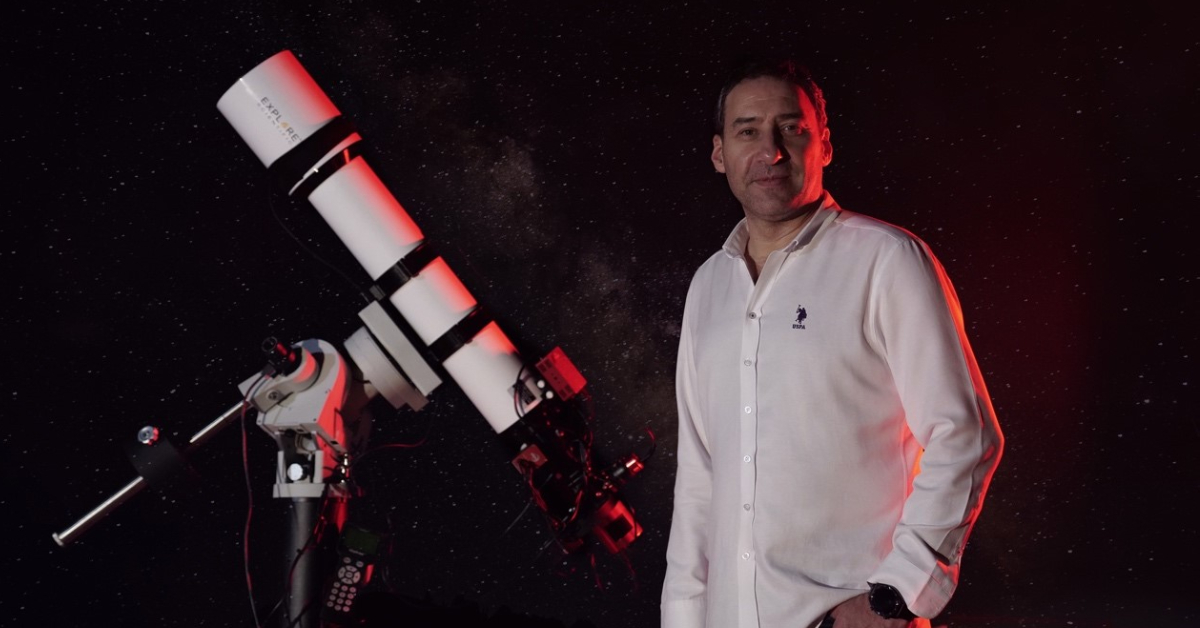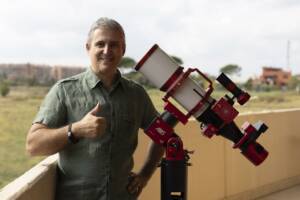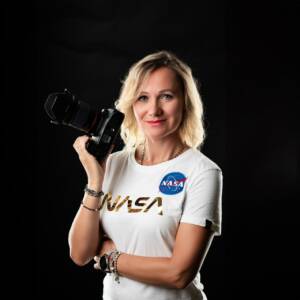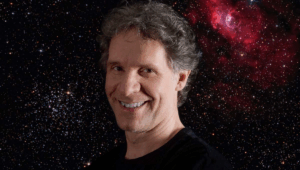
ASI 585MC Air All-in-one solution – Full Review
bbrown_admin, October 30, 2025 INITIAL IMPRESSIONS: The ZWO ASI585MC Air came well packaged from the manufacturer. The box is improved and has an impressive feel with a magnetic closure on

You might not know Wissam Ayoub before, but you might have already seen his astrophoto – the Crescent Nebula and Soap Bubble Nebula. It won a NASA APOD and a ZWO ASIWEEK, also greatly changed our expression of the Crescent Nebula.
Thank you for your recognition. My name is Wissam Ayoub, I am 48 years old based in the Abu Dhabi, UAE.
I’ve been in the videography/broadcast industry for the past 25 years and currently run the Operations department and teams in a regional news organization – however, my personal passion has always been astronomy.

Wissam Ayoub and his Telescope
When I first saw it, I thought to myself – what a great honor, how amazing. In short, I was extraordinarily happy!
I had planned to capture the Crescent Nebula for a long time and I managed to image it in the Abu Dhabi Desert, UAE, using my Explore Scientific 127mm ED TRIPLET APO and the ZWO ASI1600MM Pro Camera, the sky was very clear and the total integration time was 10 hours.
As for the processing, like any other image I process, I take my time and sometimes days to obtain the highest quality image possible.

The Crescent Nebula and Soap Bubble NGC6888, taken by Wissam Ayoub, won NASA APOD and ZWO ASIWEEK.
I always had a passion for astronomy and astrophotography, but never had the chance to pursue it. One day however, I was looking at the beautiful photos of Galaxies and Nebulae taken by the NASA’s Hubble Space Telescope and I was amazed by the beauty and the quality, and at this exact moment, I decided to be an Astrophotographer.
The first time I saw the Moon in my eyepiece I was speechless. Nothing could describe the happiness and joy I felt. Truly jaw dropping!

The Moon, 1 sub, taken by Wissam Ayoub.
I started Astrophotography in January 2019 and my first target was Orion Nebula M42 using my Celestron 8SE and a DSLR camera. I am very proud of this image as it represents my early beginnings.

Wissam Ayoub’s very first image in Feb 2019, the Orion Nebula M42 using Celestron 8SE and a DSLR camera.

Orion Nebula M42, Oct 2019, using ZWO ASI1600MM Pro camera and Explore Scientific 127mm ED TRIPLET APO.
The below are some of my gear,
Telescopes: Explore Scientific 127mm ED TRIPLET APO and Explore Scientific 80mm Triplet and Celestron 8SE.
Lens: Samyang 135mm.
Cameras: ZWO ASI1600MM Pro and ZWO ASI294MC Pro.
Guiding Camera: ZWO ASI290MM Mini.
Polemaster.
ZWO ASIAIR, ZWO ASIAIR Pro, ZWO EAF, ZWO 8x 1.25″ Filter Wheel (EFW), ZWO OAG and ZWO 1.25″ Helical Focuser.
Mounts: 2x iOptron CEM60.

Wissam Ayoub’s Explore Scientific 127mm ED TRIPLET APO with ZWO ASI1600MM Pro, ZWO ASIAIR PRO, ZWO EAF, ZWO 8x 1.25″ Filter Wheel (EFW), ZWO OAG and ZWO 1.25″ Helical Focuser, ZWO ASI290MM Mini and iOptron CEM60 mount.

Wissam Ayoub’s Explore Scientific 127mm ED TRIPLET APO and Celestron 8SE. (Old photo).

Wissam Ayoub’s Celestron 8SE, ASI294MC Pro and iOptron CEM60 mount. (Old photo).
My first ASI Camera was OSC ASI294MC Pro.
I first got the ASI294MC Pro because I read so many reviews about it and I found that all what I read about it was true, it is a great camera!
It is still my first dedicated astronomy camera and I would highly recommend it, I still use it on my other rig in wide FOVs. As I go forward in the journey of seeking perfection, I included the ASI1600MM Pro to my gear.
What a difference! To me personally, moving from a DSLR to ASI cameras was a departure.
I drive around 90 mins to reach the Abu Dhabi Desert and I enjoy it there because of the darkness it has – it’s class 4 Bortle sky.

Razeen, Abu Hiraybah, Abu Dhabi, UAE. Bortle 4 sky, waiting for the clouds to clear, it did at night!
One of the nights I was in the desert and I had a friend join me. This friend was a poisonous golden scorpion!. As I just started imaging, I couldn’t move my gear and I had to stay all night next to it as I didn’t want to hurt it as I simply intruded its territory.
One other night, I was also in the desert, all alone, extremely dark, focused on my iPad screen for hours with total darkness and complete silence for hours, at around 3 am and out of nowhere… I hear 2 guys saying Hi there!!!
This scared the hell out of me!!!
It turned out that they lived kind of nearby and tonight they were taking a (long) shortcut.
For safety reasons, I now go to the desert accompanied with a friend/s, let alone the scorpion.
I learned astrophotography by myself, having spent hundreds of hours watching related videos on YouTube, read thousands of articles and navigated through discussion forums. I came to choose my gear carefully, and here I started.
My suggestions to new beginners would be: read, read, read, learn, try, try again and again and never ever give up on your passion. If someone else on this planet did it, then YOU CAN!
I believe 2020 is my year! I achieved a lot, and more to come!
Happy to win NASA APOD, ZWO ASIWEEK, two of my images featured at Sky, one image won IOTD at Astrobin and many of my images are featured on regional platforms.
My goals for the next year are much bigger, I planned to image much more difficult deep sky targets.

The Jellyfish Nebula IC 443 and surrounding IC 444, won Astrobin IOTD and was featured at Sky.

HELIX Nebula – NGC7293, was featured at Sky.
I use the ASIAIR and the ASIAIR PRO and I love them. I can call them freedom, excellent performance and the Wi-Fi features that help me -sometimes- capture from inside my car in the freezing cold desert. Not a paid ad.
ZWO ASIAIR PRO, although it is an excellent product that helped me all the way along, its Wi-Fi range needs to be improved.
ZWO EAF, autofocus is an excellent feature, and I would appreciate if it can be developed for more accuracy.

bbrown_admin, October 30, 2025 INITIAL IMPRESSIONS: The ZWO ASI585MC Air came well packaged from the manufacturer. The box is improved and has an impressive feel with a magnetic closure on

– Q3 ASIWEEK Winner Gianni Lacroce’s Astrophotography Journey Hi, I’m Gianni Lacroce, an Italian astrophotographer. My passion for the night sky began long before I owned a telescope or a

INTRODUCTION My name is Marzena Rogozińska. I live in Bytom (Poland) and work as a psychologist and pedagogue at two schools. I would like to thank you for honoring my

Two years after winning #44/2023, Robert Eder, a sound engineer from Vienna, Austria, has once again claimed victory with #27/2025 ASIWEEK, returning to share his astrophotography journey. Combining technical skill

—— “Even though astrophotography is often considered a ‘solitary’passion, it is in fact very social when others help you through the toughest moments.” Hello, my name is Paweł Radomski, I
1 Comment
pgu-mos.su
Rodrigo Vera Castro is the winner of ZWO 2020 ASIWEEK #12 and has brought us many extraordinary astronomy photos. To make our ZWOers know this excellent astrophotographer better, we make this interview. Let’s all take a look now. Since 2018 I started to assemble my equipment for astrophotography, first I was only interested in planetarium but then I became interested in deep space so I decided to buy apochromatic telescopes and I began to take photos only with a reflex camera, in August 2019 I decided to buy my first ZWO ASI camera refrigerated astronomical camera like this and it was a radical change, my images began to be amazing.